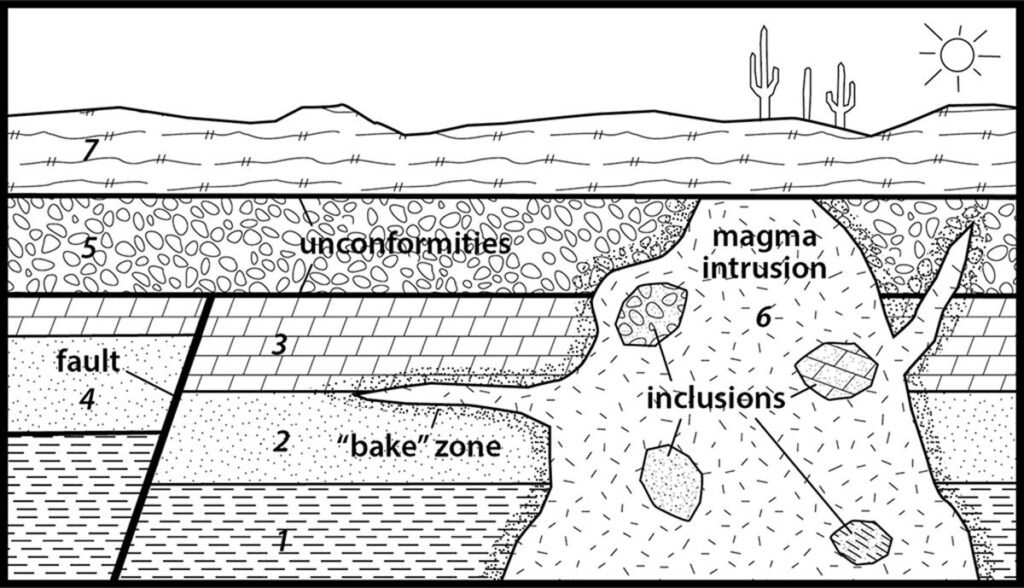The principle of inclusions states that a rock enclosing fragments of an adjacent rock is younger than the adjacent rock whose fragments it encloses.
This basic principle of geology was proposed by Sir Charles Lyell (1797-1875), a Scottish geologist and geology professor at King’s College London. Lyell also authored the Principles of Geology (1830–1833) and was associated with Sir Charles Darwin.
The inclusions principle follows basic logic, i.e., for a fragment to be enclosed or included in another rock, it must have been present when the enclosing rock formed.
An example to illustrate principle of inclusions is a sedimentary rock like shale enclosing gneiss fragments. In such a case, the shale rock is younger than the fragments of gneiss it encloses.
Last but not least, this principle helps in relative dating, i.e., knowing which rock is older than the other. It can’t, however, give you the absolute or age difference between the enclosed rock fragments and the enclosing rock.

More on the principle of inclusions
Defined simply, the principle of inclusions states that enclosed rock fragments are older than enclosing rocks. The enclosed rock fragments are the inclusions, and their composition and lithologies will vary from the enclosing or host rock.
Inclusions found in igneous rocks are called xenoliths and xenocrysts if made of individual mineral crystals. Rock fragments in sedimentary rocks are clasts, but the term clast isn’t specific.
There is nothing wrong with this definition of the principle of inclusions. However, it won’t help in relative dating unless restated in a more complete manner.
A better definition shouldn’t fail to mention that the enclosing rock and the rock whose fragments are enclosed are adjacent to each other.
When these rocks are adjacent or in contact, you can say the rock whose fragments are enclosed is older than the one that encloses the fragments.
Common scenarios
Imagine two rocks, gabbro and sandstone, are adjacent to each other, and the sandstone has inclusions of gabbro. You can deduce that gabbro is older than sandstone by applying the principle of inclusions.
The above is a basic example which is similar to scenario one. Others like igneous intrusions and sills will be slightly different. Let’s dig deeper.
1. Scenario one
The first scenario is where overlaying (igneous or sedimentary) rocks have inclusions of underlaying igneous, metamorphic, or sedimentary rocks.
In this scenario, the overlaying rocks are younger than the underlaying ones. These rocks incorporated fragments from the underlaying rocks during formation.
For instance, lava flows can pluck fragments from underlaying rocks, or sedimentary rocks can incorporate weathered or eroded fragments of the underlaying rock as they form.
2. Igneous intrusions
The second scenario is one where underlaying rocks enclose inclusions of overlaying rocks. In this scenario, the underlaying rock is younger and is an igneous intrusion that incorporated fragments of overlaying igneous, sedimentary, or metamorphic rocks.
Please don’t apply the principle of superposition in the case of intrusions since they are younger than the rock layers above them. However, if you consider the principle of cross-cutting relationships, it will confirm that the intrusion is indeed younger.
3. Sills
The last scenario is one in which a rock layer has inclusions of both the above and below rocks on its margins. This rock layer is younger than the ones above and below, and it represents a sill.
Sills form when magma pushes between rock layers, and it will pluck some rock fragments from both the upper and lower rock layers.
You can confirm if the rock layer is indeed a sill or not by checking for any evidence of baked sections both on the upper and lower ends.
Why is the principle of inclusion important?
Geologists and other Earth scientists use the principle of inclusions in relative dating, i.e., knowing which strata is younger than the other. However, it doesn’t give absolute ages, which require radiometric dating methods.
Additionally, it is possible to know the chronological order of past events. These events include sedimentary rock formation, magma intrusion, sill formation, etc.
Are there exceptions?
Host rocks may surround small, torn extrusions like dike, and it can appear as if the torn dikes are inclusions yet they are younger.
